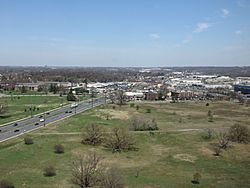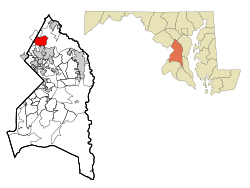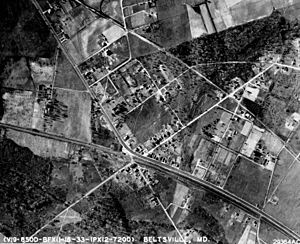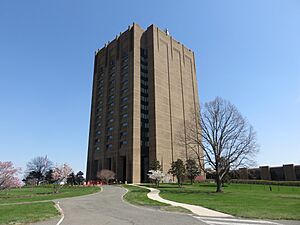Beltsville, Maryland facts for kids
Quick facts for kids
Beltsville, Maryland
|
|
|---|---|

Downtown Beltsville viewed from the top floor of the National Agricultural Library
|
|

Location of Beltsville, Maryland
|
|
| Country | |
| State | |
| County | |
| Area | |
| • Total | 7.23 sq mi (18.73 km2) |
| • Land | 7.21 sq mi (18.66 km2) |
| • Water | 0.03 sq mi (0.07 km2) |
| Elevation | 135 ft (41 m) |
| Population
(2020)
|
|
| • Total | 20,133 |
| • Density | 2,793.92/sq mi (1,078.75/km2) |
| Time zone | UTC−5 (Eastern (EST)) |
| • Summer (DST) | UTC−4 (EDT) |
| ZIP codes |
20704-20705
|
| Area codes | 301, 240 |
| FIPS code | 24-06400 |
| GNIS feature ID | 0597069 |
Beltsville is a community in northern Prince George's County, Maryland, United States. It's known as a "census-designated place" (CDP), which means it's a special area counted by the census but not officially a city or town. The community got its name from Truman Belt, who owned land there a long time ago. In 2020, about 20,133 people lived in Beltsville. The area also includes the community of Vansville.
Contents
Geography
Beltsville is located at 39°2′15″N 76°55′4″W / 39.03750°N 76.91778°W. It's right next to the border between Montgomery County and Prince George's County. Beltsville is about 7 miles (11 km) northeast of the border with Washington, D.C..
The total area of Beltsville is about 7.2 square miles (18.6 square kilometers). Most of this area is land, with only a small part being water.
Climate
Beltsville has a climate with hot, humid summers and mild to cool winters. This type of weather is called a humid subtropical climate.
Population
| Historical population | |||
|---|---|---|---|
| Census | Pop. | %± | |
| 2000 | 15,690 | — | |
| 2010 | 16,772 | 6.9% | |
| 2020 | 20,133 | 20.0% | |
| U.S. Decennial Census 2010 2020 |
|||
In 2020, the population of Beltsville was 20,133 people. This was an increase from 16,772 people in 2010.
History
Beltsville's story began in 1649. Back then, the land was part of a huge grant given to Richard Snowden I by Lord Baltimore from England. The Snowden family were planters who built large homes. Other farmers also moved to the area, living in smaller cabins. Tobacco was the main crop, and most of it was sent to England. The soil was very good for growing crops.
In the early 1700s, industry came to Beltsville when iron ore was found. The Muirkirk Iron Furnace, located on US 1, was started by Andrew and Elias Elliott. They made high-quality pig iron. This iron was used to make cannons and other products for the U.S. Army during the Revolutionary War and the Civil War.
By 1730, Post Road (now part of US 1) was the main road through Beltsville. It allowed stagecoach travel. In 1783, Gabriel Peterson Van Horn started a stage line and built the Van Horn Tavern. Travelers could stay there overnight while going between Baltimore and Washington, D.C. The trip used to take a day and a half!
Beltsville is also home to a hero from the Revolutionary War. Brigadier General Rezin Beall was born in Beltsville in 1723. He stopped a British invasion at Drum Point with only 100 men. People say he's the reason there were no Revolutionary War battles in Maryland.
In 1835, one of the first train lines in the country, the Washington branch of the B&O Railroad, was built through the area. The railroad bought land from a farmer named Trueman Belt and named the stop "Beltsville" after him. Since the Baltimore-Washington Turnpike also crossed the rail line there, Beltsville quickly became a busy trading center.
The community grew with a few homes, churches, small stores, and workshops. Later, in 1891, the Beltsville Land Improvement Company helped develop more streets and homes. They sold lots to people who wanted to live away from the busy city of Washington, D.C. Many Victorian-style and Colonial Revival houses were built. The community grew even more when an electric railway, or streetcar line, was added. This made it easier for people to travel and led to more neighborhoods being built. After World War II, Beltsville saw a lot of new development.
In 1910, the U.S. Department of Agriculture (USDA) started buying land in Beltsville for its Agricultural Research Service. This became the Henry A. Wallace Beltsville Agricultural Research Center (BARC). It grew to be a huge center for agricultural science research, covering about 14,600 acres (59 square kilometers).
Beltsville still has some historic homes and buildings. The oldest house was built in 1773. The Ammendale Normal Institute, a large three-story building from 1880, was sadly destroyed by fire in 1998.
Education
[[multiple image | perrow = 1 | total_width = 250 | align = right | image1 = Beltsville Academy, Beltsville, MD.jpg | image2 = Martin Luther King Middle School, Beltsville, MD.jpg | image3 = High Point High School sign building Beltsville MD 2022-07-14 16-30-22.jpg | image4 = Beltsville Branch Library, Beltsville, MD.jpg | footer = From top to bottom: Beltsville Academy, Martin Luther King Middle School, High Point High School, and Beltsville Branch Library ]] Beltsville has several schools for students of all ages.
Schools
Public elementary schools in or near Beltsville include:
- Beltsville Academy (which teaches students from kindergarten to 8th grade)
- Calverton Elementary School
- Vansville Elementary School
Public middle schools include:
- Beltsville Academy
- Martin Luther King Middle School
The public high school for the area is:
- High Point High School
There are also three private religious schools in Beltsville: Augsburg Academy (Lutheran), St Joseph's School (Roman Catholic), and Beltsville Seventh-day Adventist (SDA).
Libraries
The Prince George's County Memorial Library System runs the Beltsville Branch Library, where you can find books and other resources.
Notable Past Businesses
- Ritz Camera Centers, a well-known camera store chain, used to have its main office in Beltsville.
- The Beltsville Speedway was a NASCAR track that used to be in the area, but it is no longer open.
Notable People
Many interesting people have connections to Beltsville, including:
- Johnny Beall, a professional baseball player
- Matthew Centrowitz Jr., an Olympic runner
- Frank Cho, a comic book writer and artist
- Lyle Goodhue, a scientist and inventor
- Cameron Wake, a professional football player
Images for kids
See also
 In Spanish: Beltsville (Maryland) para niños
In Spanish: Beltsville (Maryland) para niños






